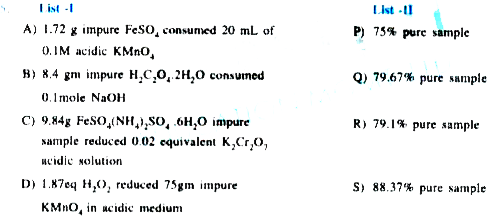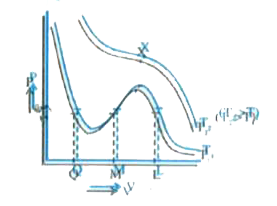10mlN2 is reacted with 20 ml H2 to form NH3. The correct statements is /areSolution in Telugu
13.3 ml NH3 is formed
20 ml NH3 is formed
3.4 ml N2 is left after the completion of the reaction
16.7 ml NH3 of mixture is left the completion of the reaction.
The correct Answer is:A, C, D
Step by step video, text & image solution for 10 ml N_(2) is reacted with 20 ml H_(2) to form NH_(3). The correct statements is /are by Chemistry experts to help you in doubts & scoring excellent marks in Class 12 exams.
Topper's Solved these Questions
- BOOK - AAKASH SERIESCHAPTER - STOICHIOMETRYEXERCISE - LECTURE SHEET ( EXERCISE III LINKED COMPREHENSION TYPE QUESTIONS)5videos
STOICHIOMETRY
- BOOK - AAKASH SERIESCHAPTER - STOICHIOMETRYEXERCISE - LECTURE SHEET ( EXERCISE III MATRIX MATCHING TYPE QUESTIONS)2videos
STOICHIOMETRY
- BOOK - AAKASH SERIESCHAPTER - STOICHIOMETRYEXERCISE - LECTURE SHEET ( EXERCISE III STRAIGHT OBJECTIVE TYPE QUESTIONS)15videos
STOICHIOMETRY
- BOOK - AAKASH SERIESCHAPTER - STATES OF MATTER EXERCISE - ADDITIONAL PRACTICE EXERCISE -PRACTICE SHEET (ADVANCED) (LINKED COMPREHENSION TYPE QUESTIONS) (PASSAGE- IV)2videos
STATES OF MATTER
- BOOK - AAKASH SERIESCHAPTER - SURFACE CHEMISTRYEXERCISE - Objective Excersice - 4 (ASSERTION (A)& REASON (R ) TYPE QUESTION)34videos
SURFACE CHEMISTRY
Similar Questions
10 moles of SO2 and 4 moles of O2 are mixed in a closed vessel of volume 2 litres. The mixture is heated in the presence of Pt catalyst. Following reaction takes place:
2SO2(g)+O2(g)→2SO3(g)
Assuming the reaction proceeds to completion.
Select the correct statement.03:02View Solution 05:14View Solution
05:14View Solution2.76 g of silver carbonate on strong ignition leaves a residue weighing
05:45View SolutionAt a particular temperature and pressure for a real gas Van der Waal's equation can be written as:
(P+aV2m)(Vm−b)=RT

where Vm is molar volume of gas. This is cubic equation in the variable Vm and therefore for any single value of P & T there should be 3 values of Vm. Which are shown in graph as Q, M and L.
As temperature is made to increase at a certain higher temperature the three values of Vm becomes identical. The temperature, pressure & molar volume at point X are called Tc, Pc & Vc for real gas. The compressibility factor in terms of Pc, Vc and T is called Zc.
The expression of Van dcr Waal's constant 'a' can be given asView Solution(A) De-emulsification is a reverse process of emulsion formation
(R ) During de-emulsification , the emulsion breaks to give oil and water.View SolutionAssertion (A) : If 30 mL of H_(2) and 20 mL of O_(2) react to form water, 5 mL of H_(2) is left at the end of the reaction. Reason (R ): H_(2) is the limiting reagent.
View Solution20 " mL of " H2O2 is reacted completely with acidified K2Cr2O7 solution 40 " mL of " K2Cr3O7 solution was required to oxidised the H2O2 completely. Also, 2.0 " mL of " the same K2Cr2O7 solution required 5.0 " mL of " a 1.0 M H2C2O4 solution to reach equivalence point. Which of the following statements is/are correct?
View SolutionA mixture pf H2,N2 and O2 occupying 100 ml underwent reaction so as to form H2O2(l) and N2H2(g) as the only products , causing the volume to contract by 60 ml. The remaining mixture was passed through pyrogallol causing a contraction of 10 ml . to the remaining mixture excess H2 was added and the above reaction was repeaped , causing a reduction in volume of 10 ml .(No other products are formed)
What is the volume of N20H2(g) formed in this reaction after adding excess of H2(g)?View SolutionHow many of the following may act as buffer ? (a) 20mL 0.2 M -H_(2)CO_(3) solution +10 ml 0.2 M-NaOH solution (b) 20 ml 0.2 M -H_(2)CO_(3) solution +20 ml 0.2 M-NaOH solution (c) 20 mL 0.2 M-H_(2)CO_(3) solution +30 mL 0.2 M-NaOH solution (d) 20 mL 0.2 M - H_(2)CO_(3) solution +10 mL 0.2 M-NaHCO_(3) solution (e) 20 mL 0.2 M -H_(2)CO_(3) solution +10 mL 0.2 M-Na_(2)CO_(3) solution (f) 20 mL 0.2 M -H_(2)CO_(3) solution +20 mL 0.2 M -Na_(2)CO_(3) solution (g) 20 mL 0.2 M -H_(2)CO_(3) solution +30 ml 0.2 M-Na_(2)CO_(3) solution
02:41View SolutionIf 30 mL of H_(2) and 20 mL of O_(2) reacts to form water, what is left at the end of the reaction?
02:48View SolutionIf 30 mL of H2 and 20 mL of O2 react to form water, what is left at the end of the experiment ?
02:06View Solution20 ml of '20 vol' H_(2)O_(2) solution is diluted to 80 ml. The final volume strength of solution is
02:20View SolutionTwo gases N2andH2 are allowed to react from mixture of N2H2(1)andN2H4(g) leaving none of the reactants. Formation of N2H2 (1) does not create any energy change whereas formation of 1 ml N2H4(g) absorbs 2 Joule energy. Ratio of volume contraction to energy change (in ml/Joule) during reaction when 30 ml N2and40 ml H2 react under similar conditions of temperature and pressure.
01:46View SolutionIf 30 ml of H2 and 20 ml of O2 react to form water, what is left at the end of the reaction ?
View Solution0.70g mixture of (NH4)2SO4 was boiled with 100 ml of 0.2 N NaOH solution will all the NH3(g) evolved and get dissolved to 250 mL and 10 mL of this solution was neutralised by using 10 mL of a 0.1 N H2SO4. The percentage purity of the (NH4)SO4 was boiled with 100 ml of 0.2 N NaOH solution till all the NH3(g) evolved and get dissolved to 250 mL and 10 mL of this solution was neutralised by using 10 mL of a 0.1 N H2SO4 solution. the percentage purity of the (NH4)2SO4 sample is-
View Solution

